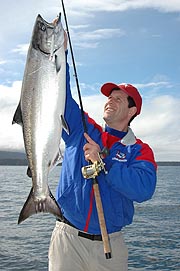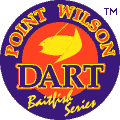|
Copyright 2006
DartJigs.com
Spring &
Summer Jigging In The San Juans Is Hard To Beat
 Long
winter nights followed by bone-numbing gray days while standing
knee-deep in my favorite steelhead drift are over. As the sun
hangs overhead longer with each passing day, the drizzly days of
springtime invite saltwater lovers to dust off the "bay boat" in
preparation of the upcoming salmon season. That's right... We will
have a salmon season this year -- limited by design, but a season with
opportunity throughout the state. Long
winter nights followed by bone-numbing gray days while standing
knee-deep in my favorite steelhead drift are over. As the sun
hangs overhead longer with each passing day, the drizzly days of
springtime invite saltwater lovers to dust off the "bay boat" in
preparation of the upcoming salmon season. That's right... We will
have a salmon season this year -- limited by design, but a season with
opportunity throughout the state.
May is a
perfect time of year to wet a line and there's no better place to take
the first fishing trip of the year than the picturesque, and easily
accessible San Juan Islands. Rain or shine, the San Juan Island
archipelago offers anglers, boaters and island hoppers a variety of
opportunities. While countless people flock to the islands for one
thing or another, the most important activity in my mind is fishing --
chinook fishing to be specific. (When fishing regulations allow).
Almost
any vessel, from 12-feet and up can take advantage of some form of
fishing. Anglers can launch their crafts at Deception Pass State Park,
Washington Park or Skyline Marina. From any of these locations, anglers
need only to travel a short distance to decent salmon and bottomfishing.
The small boater can take advantage the great salmon fishery at Fidalgo
Head or a decent bottom fishery around Burrows Island near Skyline
Marina. Anglers launching from Deception will enjoy fishing the bay for
Skate, {they look like stingrays} or just jigging for schools of
herring.
Anglers
who are lucky enough to launch sea-worthy crafts larger than the
go-almost-anywhere-length of 16-feet will be amazed with the watery
wonderland that awaits. So too are the famous San Juan Island
blackmouth, mature, stream-bound chinook, lingcod, halibut and
rockfish. Top areas in May are: Eagle Bluff, Thatcher Pass, Hein Bank,
Salmon Bank and Middle Bank. A word of caution though, regardless of
vessel size, be sure to have all safety standards up to Coast Guard
approval.
Mature
chinook pass through the area from May through the end of July in route
to the rivers and streams of their origin. It's these fish that attract
the most loyal island anglers. On some days, skillful anglers might
fight half a dozen chinook in the larger than 12-pound class. While
most of these chinook range from 12 to 25-pounds, a few monsters over 30
are taken each year.
However,
there is a catch -- on not keep in this case -- all chinook over
30-inches in length must be released through June 15th. The limit of
sub 30-inch salmon remains two and remains two after that date until
July 31st. Beginning August 1st through September 30th, anglers are
allowed four salmon per day, only two of which may be chinook.
Jigging
for salmon is probably the easiest way to latch onto an island fish, of
any species. Once almost any fish is hooked while jigging, a life-long
love of Pacific Northwest saltwater fishing overwhelms the lucky
angler. I know that's a strong statement, but it happened to me,
therefore I believe it to be true!
 All
that's needed for anglers to begin their jigging career is a medium to
heavy action rod, a level wind or spin casting reel loaded with 15-pound
test monofilament, a fish/finder and a handful of 2 1/4 ounce greenback,
chrome-sided Pt. Wilson Darts candlefish jigs. Without
these exact jigs, you might as well stay home. Years of experimenting
with every jig on the market has proved this jig most popular among
hungry mature chinook. When it comes to bottomfish, if it sinks to the
bottom, stays there any length of time and you don't loose it, it's sure
to catch fish. All
that's needed for anglers to begin their jigging career is a medium to
heavy action rod, a level wind or spin casting reel loaded with 15-pound
test monofilament, a fish/finder and a handful of 2 1/4 ounce greenback,
chrome-sided Pt. Wilson Darts candlefish jigs. Without
these exact jigs, you might as well stay home. Years of experimenting
with every jig on the market has proved this jig most popular among
hungry mature chinook. When it comes to bottomfish, if it sinks to the
bottom, stays there any length of time and you don't loose it, it's sure
to catch fish.
Learning
to jig is easy. During spring and summer, salmon feed on Pacific Sandlance, AKA, candlefish. Most San Juan Island salmon take the jig
within 5-feet of the bottom, so stay "on the deck" with the jig.
Anglers simply disengage their reel and let the jig free-fall to the
bottom. As soon as a pause or thump is felt, engage the reel and set
the hook hard. When the jig hits bottom, reel three turns to avoid a
bottom grabbing rock, then begin the gentle up and down motion
synonymous with jigging.
Each
angler has a unique stroke or swing that often resembles a yo-yo
motion. A steady upward swing of the rod followed by the rod tip
pointed quickly toward the water is a productive way to jig. Salmon
will attack a jig more often on the fall than the retrieve or up-swing
motion so stay alert.
Finding
salmon in the San Juans is easy if you concentrate efforts along the
Rosario Strait corridor, where migrating and spawning candlefish attract
hungry, feeding salmon. "Where you find bait, you should find salmon"
says Marc Krueger, owner/operator of Fish Tales Guide Service in
Anacortes.
Calm
waters, along the edges of the Rosario Strait corridor offer plenty of
opportunities to find schools of candlefish, herring and salmon that
feed on them. These productive areas also shield anglers from inclement
weather.
Currents
play an important role when jigging the San Juan Islands. As the
currents rush through the islands, they create eddies and pockets that
trap bait, which in turn attract feeding salmon. Most of the hot spots
mentioned earlier are within easy range of Anacortes and they offer all
the necessary ingredients that spell FISH IN THE BOX.
Here's a
couple more locales that should provide top jigging action in May, June
and July:
Black
Rock and Pointer Island: Check your tide or current tables and fish here
during the ebb tide. Concentrate efforts along the edges of the small
bank, usually in the 90 to 120-foot range.
Decatur
Head: Decatur fishes well on either tide. Jiggers cover the large flat
between James Island and Fauntleroy Point with excellent results.
Often times, jigging and fish-catching takes place in 30-feet of water.
Don't overlook the steep drop-offs close to shore at Decatur Head, they
provide excellent shallow water action when baitfish are trapped against
the rock precipice.
Secret Harbor: Jig
in 60 to 90-feet of water on either side of the shelf in the middle of
the harbor. Find the bait and jig within 5-feet of the bottom. An ebb
or flood tide is productive here and don't be surprised if a "Flatie"
scarfs down your jig.
Sinclair Reef:
Located between Sinclair Island and Lawrence Point. The easiest way to
find this productive hotspot is to simply locate buoy 16, directly over
the mid-section of the reef. The tide rips through Sinclair Reef making
fishing difficult except during the end of the ebb and slack tide. The
reef shelfs off at 72-feet and is surrounded by deeper water. The most
productive depth is the 120 to 130-foot ledge.
Since
tides and direction of current-flow affects where and when salmon will
be found, especially in the San Juan Islands, anglers should know when
and where to find "prime" water. The best way to keep track of currents
in the San Juans is to use a current guide. Tide tables alone will not
give enough information to be helpful to the "Rookie" fishermen.
Anglers can learn when and where to drop a jig for salmon and bottomfish
from CAPTn JACK'S tide & current almanac and their current atlas of the
same name. Both are available through a marine supply or sporting goods
store.
If you would like more information about fishing the San Juan Islands,
or you would like to get on-the-water expert help, you may want to call
a knowledgeable guide in the area.
|
Copyright
DartJigs.com 2006 |
|
|

